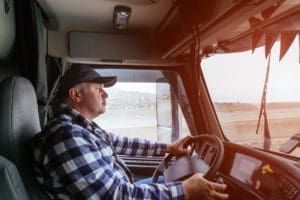CB Radio Etiquette for Truck Drivers

Whether you have been driving for years or just started, brushing up on your CB radio etiquette is always a good idea. CB radios have been used in the trucking industry for decades, and having a strong knowledge of the terminology, etiquette, and style can help you build a community among other drivers and stay safer on the road.
CB Radio Etiquette for Truck Drivers
Some CB radio etiquette tips for truck drivers may sound obvious, but following these guidelines can make even a brand-new driver sound like a pro through his radio.
Keep it Simple
First and most importantly, your messages should be simple and to the point. CB radios are not meant for long conversations or people to monologue. It is first and foremost to be able to share important and necessary safety communication. With that in mind, you do not want to have more than a sentence or two at most when speaking on the radio.
Speak Clearly
Because the messages have to travel through the waves of static, it is essential to enunciate when speaking. You should also speak slightly slower than usual. And there is no need to be loud – the microphone will automatically amplify your voice. This basic CB radio etiquette should keep you from repeating yourself multiple times.
To make sure your voice sounds clear over the radio, use the talk-back function to double-check the sound and static. If your voice is unclear, you will need to adjust the mic or RF to reduce the noise from your surrounding environment. Making these adjustments will allow you to sound right the first time.
Nothing Confidential
It should be a given, but it is worth remembering that you should only be sharing something confidential over a CB radio if you have exclusive use over the frequency. Staying private is especially important if you are on the job while using the radio.
There is no need to share what you have on board, its value, or where you are going, as that information can be used to target your truck. You do not want to get in trouble with your company because of a lack of CB radio etiquette.
Learn the Lingo
Speaking on CB radio is akin to learning a second language at times. There are hundreds of words to know and use, and the more you chat on a CB radio, the more you will learn and the better you will understand other radio users. There are thousands of terms, but some key phrases include:
- Chicken coop – a weight station
- Back door – behind your truck, often used to mean someone is behind you
- Alligator – a piece of a blown truck tire is in the road
- Pickle Park – a rest area
- Back off the hammer- slow it down
- Yo-you – a driver that speeds up then slows down
- Zipper – painted lines on the road
- Salt Shaker – a snow plow
However, some of the most critical parts of the CB radio lingo are not words at all; they are codes. Some of the most popular codes include:
- 10-4 – message received
- 10-10 – transmission complete
- 10-20 – identifying your location (sometimes rephrased as “What is your 20?”)
- 10-38 – ambulance needed
- 10-200 – police needed
Do Not Step on Other Callers
Try to avoid transmitting a message at the same time as another operator, and make sure to let someone respond first before you chime in. You would not want someone talking over you at a party, so why do it to someone else on the radio?
No Channel Holding
Remember, everyone is allowed to use a channel. Because of this, holding a channel for more than a few minutes is considered impolite.
Watch Your Language
You never know who may be listening to you on the CB radio. Because of this, you should be careful of your language. Non-truck drivers may be tuning in, which can occasionally include children. You don’t want to hurt the general public’s opinions of professional drivers, and it’s important to keep your possible audience in mind when thinking about CB radio etiquette.
Where Does CB Radio Etiquette Come From?
The CB radio was invented in 1945 as one of the many personal radio services regulated by the Federal Communications Commission (FCC.) Originally serving as a way for World War Two troops to talk to each other, the creator, Al Gross, also invented the walkie-talkie.
Today, using a CB radio is synonymous with truck driving. However, it was in the 1970s that the use of the CB radio became popular among truck drivers.
This came about due to the oil crisis of the time and the changing speed limits. The United States government imposed a nationwide speed limit of 55 miles per hour, which greatly affected independent truckers paid by the mile. The changing speed limit caused their productivity to drop naturally, and their paychecks suffered. This is where the CB radio comes in. Drivers were able to use their CB radios to late service states with fuel and other supplies, notify other drivers of emergencies, and organize protests against the speed limit with events like like blockades and convoys (as immortalized in the novelty county song “Convoy”)
Since then, truckers have continued using these short-distance communication devices to keep each other in the loop about accidents, events, and additional important information that could affect driving times or safety.
CB Radio Etiquette for Truck Drivers: Learn More with TDI
Many of our staff members at the Truck Driver Institute are former drivers who now pass their wisdom on. This gives them a wide range of knowledge on all the different sides of professional truck driving – from the actual mechanics of driving to CB radio etiquette. Contact us today to learn more about how TDI can help you change your life in just a few weeks!
Get Started
Get your Class A CDL in our friendly, supportive CDL training program. TRAIN with experienced instructors – multiple good-paying, secure job choices with benefits available for eligible graduates. EARN $700 – $1000+ / week to start as a truck driver. Get started today by filling out the form below. We look forward to hearing from you!



